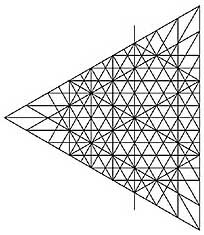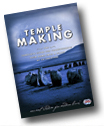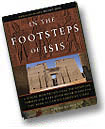
 |
||||||
|
Drawings and text © Freddy Silva 1997. Photos © Lucy Pringle and Dr. Andrew King. Once again the Circlemakers up the ante with a fractal version of the Star Of Solomon, a more complex version of its earlier cousin at Silbury Hill. Located below Milk Hill, this one stands over 200 ft long in wheat and was discovered by farmer Nick Riley at 6 AM. The formation sets a new current record at 204 circles. With the addition of the central fractal pattern the design completes a sequence of hexagonal geometry. The design itself is again based on the Pythagorean geometry found in the earlier formation at Silbury Hill. For the benefit of those who hold steadfast to the notion that all crop circles are man made I have taken the time (about four days) to demonstrate just how this year's Milk Hill crop circle, and its simpler cousin at Silbury hill, could be made over the course of an evening, with some of your chums on-hand to help. |
|||||||||||||||||||||||||||||
 |
|||||||||||||||||||||||||||||
 |
|||||||||||||||||||||||||||||
| First off is a lesson in geometry. Fig 1 (left) is a Tretactys. You will only know this if you are conversant with Pythagoras and Egyptian esotericism. For those discerning minds, this symbol contains the mystery of universal nature- the three creative points of light and the seven intervals of the pure music scale (or the seven creative periods of God plus the threefold, invisible causal universe.) | |||||||||||||||||||||||||||||
 |
|||||||||||||||||||||||||||||
|
Fig 2. By connecting the ten dots of the Tetractys, nine triangles are formed, six of which form a cube. This begins to reveal the six-pointed star in the centre. Now comes the hard part. You have to take this basic plan into a field of wheat. To make matters slightly more complicated you and your group of helpers need to loaf about until, say, midnight; for this is summer in England and it is still possible to see people without the aid of electrically-generated lighting at 11.30 PM. You will then be required to wear very dark clothing to conceal your whereabouts in the field. Lights are out of the question because you are located at the foot of a steep hill, from the top of which it is highly likely that several groups of people will be religiously watching you, in the vain hope of witnessing a genuine crop circle appearing. But tonight you will fool the poor bastards with your lethal cunning. Also don't forget that farmers are out checking the fields for pests like you. So the use of night vision equipment, as cumbersome as it is, may be permitted. |
|||||||||||||||||||||||||||||
| Now the work begins. Because this is a particularly tricky one to attempt we shall forego the usual scientific proceedures at the end of your work that will verify signs of genuineness- plants bent not broken, higher radiation levels, electromagnetic anomalies, dowsing confirmations, soil dehydration, changes in the plants at cellular level, just to name a few. And besides, you will have to contend with tenacious mud all night because the clay ground is sopping wet beneath your feet and, frankly, any attempt to walk over grain will either yank the said crop out of the ground or will cover it in a dull blanket of grey/brown earth. This will give the game away, so avoid it at all costs. Right, you now have four hours before it gets light again. Begin. | |||||||||||||||||||||||||||||
 |
|||||||||||||||||||||||||||||
|
Fig 3. Oh dear. I forgot to tell you- the previous diagram was just the blueprint. You and your friends will first have to bisect a few angles in order to lay down a latice grid. Sorry, there's no shortcut here: without this maze you will never line up the pattern outline, let alone the 204 circles which will be embellished upon completion. And try not to make a mess of the wheat while you are laying this on the ground. You are also not allowed to place stakes to mark the centers- you will leave telltale signs of hoaxing. |
|||||||||||||||||||||||||||||
 |
|||||||||||||||||||||||||||||
|
Fig 4. Well, that wasn't so difficult, was it? Now you have the basic shape. Try to lay the crop down neatly so it folds like a river, with centers circular and slowly becoming triangular to establish the sharp perimeter walls. And don't get that mud on the laid down stems or we will know you have been all over it. Then take a break, otherwise your body odour will attract bands of sex-mad hedgehogs. Which will only complicate matters. |
|||||||||||||||||||||||||||||
 |
|||||||||||||||||||||||||||||
|
Fig 5. Remember that latice grid in fig 3? Now you'll have to do the same to create the edges for the reverse fractal in the middle. And for heaven's sake- don't treat into the standing crop or you will crease the plants and give the game away. Since all the circles are several feet apart from each other, with standing crop in-between, you will have to levitate over the field so as not to make a mark while laying down the perfect spirals in each one. And you won't forget to do this for all 204 circles now, will you!? Incidentally, how are you going to accomplish this? You have about 240 minutes of night cover, which means just over 60 seconds per circle. No, you can't waste time for a pee. |
|||||||||||||||||||||||||||||
 |
|||||||||||||||||||||||||||||
|
Fig 6. There, that wasn't so hard. And all of them with standing crop in each center- a very nice touch. It shows that attention to detail is not dead in the world. How does it all look with the crop laying down softly above the soil? |
|||||||||||||||||||||||||||||
 |
|||||||||||||||||||||||||||||
| Fig 7. You are a genius, a true renaissance man/woman/in-between. Now go get some sleep and don't walk around the area for a while. The lack of sleep on your face, not to mention all the mud, will give you away as the original artist of this higher form of mathematical art. But how close does it match the real thing? | |||||||||||||||||||||||||||||
 |
|||||||||||||||||||||||||||||
| Fig 8. Honestly, it just leaves you speeechless. | |||||||||||||||||||||||||||||
|
|
|||||||||||||||||||||||||||||
|
Left: The fourth fractal-style crop circle of the year, this one at Hackpen Hill just north of Avebury. Hackpen is an ancient name for 'serpent' which is also an allegorical reference to the earth energy that snakes around these hills. Everything about this crop circle is perfect except for one minute detail- the bottom arrow shows one circle missing from the whole sequence, and this shows up as a grapeshot next to the top arrow. This feature is not unique and is a hallmark of important formations. It follows the ancient tribal belief that only the Creator is perfect, and when replicating the Creator's work it is important to leave one element slightly off. This crop formation follows the same geometric principle applied with the Milk Hill and Silbury Hill formations earlier this year. The design itself is reminiscent of patterns in chaos theory called Strange Attractors, and they appear whenever systems in dynamic flux are on the verge of realigning to a new order.
Possibly two of the most important formations of the year lie beside each other, running Magnetic North, and in the same field occupied last year by the famous Base Chakra symbol and the 3/4 mile-long avenue (whose course could still be seen this year through the newly sown field). The first consists of a square within a circle, the former grided with 28 lines by 25, each running in counterflow. The grid avenues are about 7 inches wide. From the air it resembles a very large silicone chip. The information contained in this grid will be of vital importance to the deciphering and use of crop circles in the future. My research traces this checkerboard method of communication to Freemasonic symbolism, with this particular emblem signifying the Mystery of the Microcosm. Its earliest use was by Pythagoras (who was himself a Freemason), but the origins go back to the Dionysiac Architects. These enlightened beings refered to themselves as the Sons of Solomon (whose symbol ironically is the six-pointed star), and carried with them the knowledge of the Gods, especially in matters of building, proportion and harmony. Their efforts, thanks to the use of sacred geometry, gave us not only some of the most perfect structures on Earth but also edifices that would stand the tests of wrath and time – the Temple of Diana, the Colliseum and the Pyramids of Gizeh are among their best efforts. Today we see their knowledge passed down through modern Freeemasonry, one spectacular example being the Jefferson Memorial in Washington (our Thomas was also a member of the Order). The Doctrine of Freemasonry, like that of the Dionysiac Architects, is (or used to be) concerned primarily with the effort to measure or estimate philosophically the parts and proportions of the microcosm, so that knowledge derived from the supreme ambition of their craft might be realized- the creation of a perfect humanity. According to Plato, the foundation plan of Atlantis was firmly based on the squared circle, the geometer's device for transforming the ideal into the actual. It's numerical framework consisted of canonical numbers such as 5040, 3168 and 144. I find it interesting that in these times of ever-escallating superficial values we appear to be given reminders of the past so we can re-stock our physical and spiritual library in order to understand how to build a new and better future. I don't hide the ominous intention of this thought because at moments like this it feels to me that these symbols, now handed to us over twenty years, are beginning to take on the nuance of a Noah's Ark. Except this time we will be harbouring not animals, but the blueprints of life. It's just a thought. 150 feet north of the first formation lies a six petalled star with an elegance of unsurpassed quality, as if we are looking at the very symbol of Atlantis itself. I even remember saying this at the site for no apparent reason. Part of this summer's work was taken up with discovering the secrets of music, sound, and their connection to and beneficial use via crop circles. I performed an experiment within this formation very late at night and some very etherial things took place while I was playing certain sounds. The whole incredible experience is published in my book. |
|||||||||||||||||||||||||||||
 |
|||||||||||||||||||||||||||||
 |
|||||||||||||||||||||||||||||
 |
|||||||||||||||||||||||||||||
 |
|||||||||||||||||||||||||||||
 |
|||||||||||||||||||||||||||||
 |
 |
 |
 |
||||||||||||||||||||||||||
 |
|||||||||||||||||||||||||||||
 |
|||||||